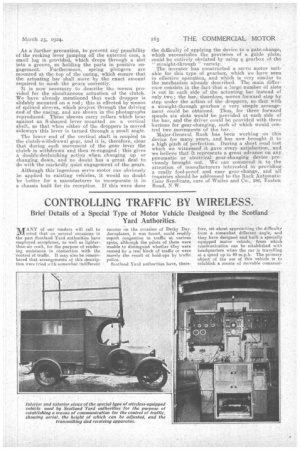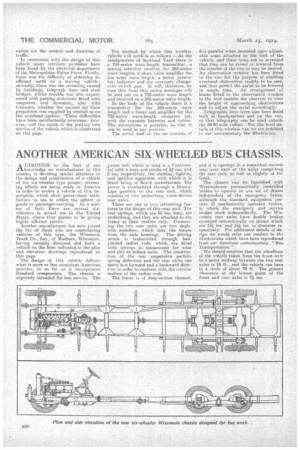CONTROLLING TRAFFIC BY WIRELESS.
Page 11

Page 12

If you've noticed an error in this article please click here to report it so we can fix it.
Brief Details of a Special Type of Motor Vehicle Designed by the Scotland Yard Authorities.
Aff ANY of our readers will call to IVA mind that on several occasions in the past Scotland Yard authorities have employed aeroplanes, as well as lighterthan-air craft, for the purpose of rendering assistance in connection with the --control of traffic, It may also be remembered that arrangements of this description were tried with somewhat indifferent
success on the occasion of Derby Day. Aeroplanes, it was found, could readily report congestion in traffic at various spots, although the pilots of them were unable to distinguish whether tHey were caused by a real block of traffic or were merely the result of hold-ups by traffic police.
Scotland Yard authorities have, there fore, set about approaching the difficulty from a somewhat different angle; aud they have designed and built a specially equipped motor vehicle, from which communication can be established with headquarters when the car is travelling at a speed up to 40 m.p.h. The primary object of the use of this "vehicle is to establish a means of movable communi
cation for the control and direction of traffic.
In cennection with the design of this vehicle many intricate problems have been faced by the electrical department of the Metropolitan Mice 'Force. Firstly, there was the difficulty of obtaining an efficient earth on a moving vehicle ; secondly, there seas the screening caused by buildings, telegraph lines and steel bridges, Whilst trouble was also experienced with passing motorcars fitted with magnetos and dynamos, also with tramcars, whether the current 'for their prcipulsiort was supplied by conduit or on the overhead system. These difficulties have been satisfactorily overcome, however, and the result. is the putting into service of the vehicle which is illustrated on this page.
The method by which. tins wireless vehicle will work is as follows :—At the headquarters of Scotland Yard there is a 732-metre wave-length transmitter, a special selective receiver for 265-metre wave lengths, a short valve. amplifier•for. the same wave length, a motor genera---tor, batteries and the necessary changeover switch gear, It will, therefore, be seen that from this centre messages will he sent out on a 732-metre wave length and received on a 265-metre wave length.
In the body of the vehicle there is a transmitter for the 265-metre wave length and a tuner and amplifier for the 732-metre wave-length reception set, with the requisite batteries and valves. The microphone is• portable, so that it can be used in any position. The serial used on the car consists' cif five parallel wires mounted upon adjustable arms attached to the roof of the vehicle, and these arras are so arranged that they can he raised or lowered front the intenor of the van as may be desired. An observation window has been fitted to the-van for the 'purpose of enabling overhead obstruction readily to be seen, and thus permit the aerial to be lowered in ample time. An arrangement of lenses fitted to the observation window in the roof enables the -observer to view the height of approaching obstructions and to adjust the aerial accordingly. ,
Telegraphic keys have also been fitted both at headquarters and on the van, so that telegraphy can be used outside the 30-40-mile radius'. For the brief details of this wireless van we are indebted. to our contemporary the Electrician.






























